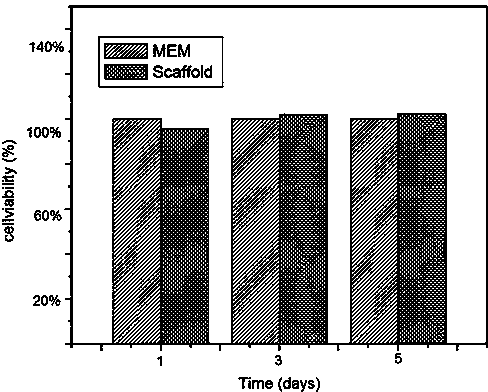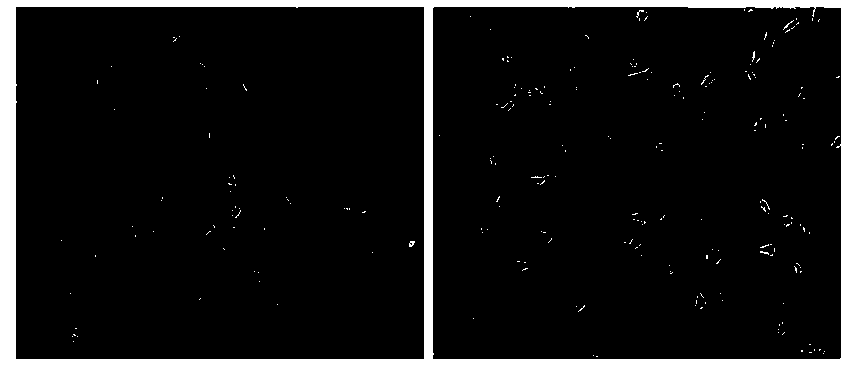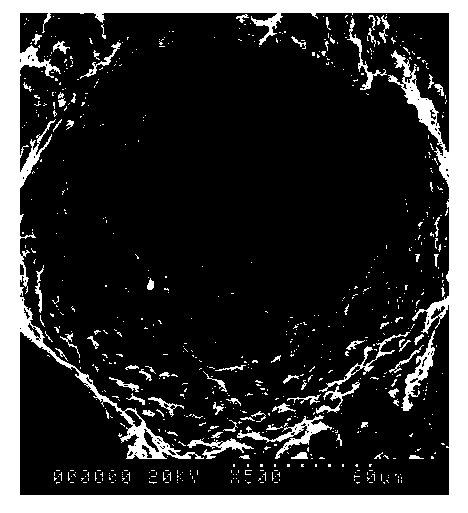Artificial bone scaffold material for enhancing biocompatibility and preparation method thereof
A biocompatibility and scaffold material technology, applied in the field of biocompatibility-enhancing artificial bone scaffold materials and their preparation, can solve the problems of inconsistent micropore pore size, small pore size, growth and ingrowth of vascular tissue, etc. The effect of improving biocompatibility, reducing adhesion, and reducing safety hazards
- Summary
- Abstract
- Description
- Claims
- Application Information
AI Technical Summary
Problems solved by technology
Method used
Image
Examples
Embodiment 1
[0037] Step 1: dissolving collagen in deionized water to prepare a collagen solution with a mass fraction of 20%.
[0038] Collagen is full-length collagen, collagen polypeptide, and gelatin extracted from animal tissues.
[0039] Step 2: Adjust the pH value of the collagen solution to 5.
[0040] The pH adjusting agent is selected from sodium hydroxide solution and hydrochloric acid solution, and the molar volume concentration is 0.01-1mol / L.
[0041] Step 3: Add transglutaminase at a ratio of 2 U / g to collagen.
[0042] Step 4: adding nano-hydroxyapatite according to the mass ratio of collagen to nano-hydroxyapatite at a ratio of 1:2 to obtain a viscous emulsion.
[0043] Step 5: Transfer the viscous emulsion in Step 4 to a mold, react at 30° C. for 24 hours, and let it cool down.
[0044] Step 6: Carry out enzyme inactivation at 90°C for 5 minutes, and place to cool.
[0045] Step 7: Pre-freeze in an ultra-low temperature refrigerator at -80°C for 3 hours, and then vacu...
Embodiment 2
[0047] Step 1: dissolving collagen in deionized water to prepare a collagen solution with a mass fraction of 30%.
[0048] Collagen is recombinant collagen and human-like collagen produced by genetic engineering.
[0049] Step 2: Adjust the pH value of the collagen solution to 6.
[0050] The pH regulator is selected from potassium hydroxide solution and sulfuric acid solution, and the molar volume concentration is 0.01-1mol / L.
[0051] Step 3: Add transglutaminase according to the ratio of transglutaminase to collagen of 8 U / g.
[0052] Step 4: adding nano-hydroxyapatite according to the mass ratio of collagen to nano-hydroxyapatite at a ratio of 1:3 to obtain a viscous emulsion.
[0053] Step 5: Transfer the viscous emulsion in Step 4 to a mold, react at 40°C for 30 hours, and let it cool.
[0054] Step 6: Carry out enzyme inactivation at 90°C for 5 minutes, and place to cool.
[0055] Step 7: Pre-freeze in an ultra-low temperature refrigerator at -80°C for 3 hours, and th...
Embodiment 3
[0057] Step 1: dissolving collagen in deionized water to prepare a collagen solution with a mass fraction of 40%.
[0058] Collagen is recombinant collagen and human-like collagen produced by genetic engineering.
[0059] Step 2: Adjust the pH value of the collagen solution to 7.
[0060] The pH adjusting agent is selected from sodium carbonate solution and phosphoric acid solution, and the molar volume concentration is 0.01-1mol / L.
[0061] Step 3: Add transglutaminase according to the ratio of transglutaminase to collagen of 15 U / g.
[0062] Step 4: adding nano-hydroxyapatite according to the mass ratio of collagen to nano-hydroxyapatite as 1:4 to obtain a viscous emulsion.
[0063] Step 5: Transfer the viscous emulsion in Step 4 to a mold, react at 55° C. for 36 hours, and let it cool down.
[0064] Step 6: Carry out enzyme inactivation at 90°C for 5 minutes, and place to cool.
[0065] Step 7: Pre-freeze in an ultra-low temperature refrigerator at -80°C for 3 hours, an...
PUM
 Login to View More
Login to View More Abstract
Description
Claims
Application Information
 Login to View More
Login to View More - R&D
- Intellectual Property
- Life Sciences
- Materials
- Tech Scout
- Unparalleled Data Quality
- Higher Quality Content
- 60% Fewer Hallucinations
Browse by: Latest US Patents, China's latest patents, Technical Efficacy Thesaurus, Application Domain, Technology Topic, Popular Technical Reports.
© 2025 PatSnap. All rights reserved.Legal|Privacy policy|Modern Slavery Act Transparency Statement|Sitemap|About US| Contact US: help@patsnap.com



